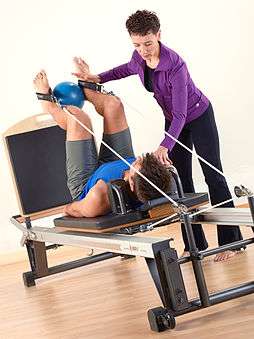Stott Pilates
Stott Pilates is a branded version of the Pilates method of physical exercise that was developed by Moira Merrithew (née Stott) and commercialized by Moira with her husband, Lindsay Merrithew, starting in 1988. The most significant difference between Stott Pilates and Joseph Pilates's original method of the early 1900s is that Stott focused on having a neutral spine posture and generated a different sequence of exercises.
 | |
| Brand | |
| Industry | |
| Founded | Toronto, Ontario, Canada (1988) |
| Headquarters | , Canada |
Area served | Worldwide |
Key people | Lindsay G. Merrithew, Co-Founder, President, and CEO, Moira Merrithew (née Stott), Co-Founder and Executive Director of Education |
| Services |
|
| Parent | Merrithew |
| Website | merrithew |
History
Moira Stott had been a dancer with the Bermuda Ballet,[1] and principal dancer with the City Ballet of Toronto and the Atlantic Ballet Company,[2][3] but had to retire when she was 24 due to chronic foot injuries stemming from her having broken her foot as a child.[4] She was advised to explore Pilates by people at the Dancer Transition Resource Centre in Toronto, and she went to New York City to study with Romana Kryzanowska, a disciple of Joseph Pilates.[4] By that time she had met Lindsay Merrithew, who was working in New York at the time.[4] Merrithew had a business degree and had also trained at Juilliard, and was trying to develop an acting career at the time.[4][5]
In her own Pilates training and work, Stott found that there was not emphasis on establishing and strengthening a neutral spine posture, and also found that traditional Pilates didn't follow the sequence of exercises that had evolved in the field of dance, and she developed a version of Pilates that came to carry her maiden name as its brand.[4][3][6]
The two of them moved back to Toronto in 1987, and in 1988 they opened a Pilates studio in their apartment and worked other jobs to make ends meet.[4][7] Their business struggled until Karen Kain, a principal dancer with the National Ballet of Canada started to take classes in their apartment; they managed to get the press to cover this, with Kain's help, and the business began to grow, allowing them to move to a studio.[4] They also received a small grant from the National Research Council.[7] As the company developed, in general Moira handled the training and program development, and Lindsay handled the business matters and marketing.[4][7]
Training became an important element of the business model from the beginning, as they eventually had to train more instructors for the studio, and they eventually created a certification program.[4] For an instructor or instructor trainer to maintain Stott Pilates certification, he or she must attend a minimum number of courses and workshops each year; thereby keeping current with the method.[8][9] Many Stott Pilates courses and workshops are part of the Continuing Education Credit (CEC) programme, and many of them are also recognized by outside organizations, including the American Council on Exercise (ACE).[10]
In the mid-1990s, the company started to publish videos[11] and DVDs of most of its programs,[12] and in several languages. Publishing DVDs increased the awareness of the Stott Pilates method.[13]

References
- "History". Bermuda Civic Ballet. Retrieved 8 July 2013.
- "Pilates who's who". Pilates Insight. Retrieved 8 July 2013.
- Mercer, Lisa. "Stott Pilates and the Spine". LiveStrong.com. Retrieved 10 July 2013.
- O’Connor, Anne Marie (July–August 2013). "A Complementary Couple". Pilates Style. Archived from the original on 16 September 2013.
- Monroe, Mary (February 1, 2008). "Moira and Lindsay G. Merrithew". Ideafit.
- Mercer, Lisa. "What is the difference between Pilates and Stott Pilates". LiveStrong.com. Retrieved 10 July 2013.
- Watson, Thomas (April 1, 2002). "Power couple: Moira Stott-Merrithew and Lindsay Merrithew are striking it rich with the hot exercise trend called Pilates, but managing their company's explosive growth might be a stretch". Canadian Business. Archived from the original on July 30, 2014.
- Binnendyk, Christine. "Stott Pilates Certification". LiveStrong.com. Retrieved 10 July 2013.
- Arnett, Alison. "As millions throng to Pilates classes, questions emerge over certification for teachers". Stretched to the max. The Boston Globe. Retrieved 10 July 2013.
- "ACE-Approved Providers". Advanced Course Search Results. American Council on Exercise. Retrieved 10 July 2013.
- Beale, Lucy (2005). The Complete Idiot's Guide to Healthy Weight Loss. New York City: Alpha Books, Penguin Group. p. 354. ISBN 1-4362-9402-9.
Moira Stott.
- "Buying a Home Exercise Video or DVD" (PDF). Does the instructor have a good reputation?. Windsor-Essex County Health Unit. Retrieved 10 July 2013.
- Bergen, Teresa. "IDEA World Fitness Convention Includes MindBody Crowd". Yogi Times. Retrieved 10 July 2013.